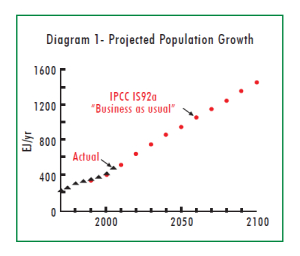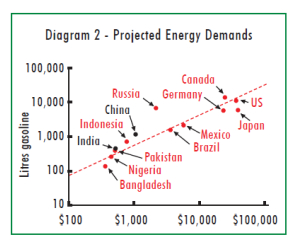Dispelling the myths: As of August 2010, there were 440 nuclear plants generating electricity in 29 countries and 61 under construction in 15 countries.[i] France derives more than 85% of its electricity from nuclear power and has the cleanest air in Europe.[ii] More and more countries are looking at nuclear power as a viable alternative to fossil fuels to meet their electricity demands.
High-density fuel: One pea-sized uranium pellet used in a power plant is equivalent to 1 ton of coal.[iii] To produce 1000 MW of electricity for one year requires: 3.8 million tonnes of coal, compared to 1.6 tonnes of uranium, using the 100 times more fuel efficient fast breeder reactors. This comparison shows why countries with little or no coal resources find nuclear power very attractive.
New reactor design: Most of today’s nuclear reactors are thermal reactors and use less than 1% of the energy in the uranium.[iv] The remainder is waste and some is radioactive enough to be of concern for thousands of years. However, an alternative design, known as fast reactors, uses virtually all of the energy in the uranium and are 100 times more fuel efficient than thermal reactors. The waste from fast breeder reactors is more easily managed because the fast neutrons split almost all of the long-lived nuclear waste products associated with thermal reactors. The radioactive materials remaining from fast reactors are of concern for less than 500 years, rather than thousands of years. Furthermore, existing waste from thermal nuclear plants is suitable fuel for the fast breeder reactor design. Safety of thermal reactors is proven. The design and operation of fast breeder reactors involves similar procedures to those for thermal reactors. The small differences tend to favour fast breeder reactors. Both types of nuclear reactors can grow because safety is under control. It is not an engineering problem; if this were not true, then more than 60 new nuclear plants, including two fast breeder reactors, would not be under construction as of August 2010.
What about alternatives? Energy Conservation: People use energy in many ways to make their lives more enjoyable, which is their right in a free society. This is often controversial because what some consider frivolous, others see as essential. Conservation saves a relatively small amount of energy, but can extend fossil fuel supplies and give more time to implement solutions. We must all save energy in our own way, however we can.
Energy Efficiency: Increases in energy efficiency are positve. However, most of the easy increases have already been achieved. Many technologies are already mature, such as wind, hydro and electricity generation, thereby leaving little potential for increased energy efficiency.[v] [vi] Furthermore, improved efficiency has a history of spurring energy consumption. Computers of the 1960s consumed much power and were housed in air-conditioned rooms. Total power consumption was negligible. Today’s computers are much more efficient, but there are so many that electricity demand has increased.[vii]
Renewable Energy: Hydroelectric power is virtually the perfect form of energy, but its worldwide growth potential is limited. Biomass projects, such as making ethanol from corn, provide little net energy benefit. By the time you plant, water, harvest, transport, and process the corn, you have used almost as much high-grade energy as there is in the final fuel.[viii] [ix] Wind and solar power are part-time and contain very little power.[x] Therefore, reliable power from fossil fuels or hydro must cover the gaps.[xi] Wind power is small and will remain small for good technical reasons - it only exists through generous subsidies.[xii][xiii][xiv][xv] Taken together, renewable energies are much too small to replace fossil fuels now and in the future.
The Hydrogen Economy: Hydrogen is not a source of energy, but an energy carrier, like electricity. It is manufactured using energy. Liquid hydrogen is 4 times bulkier than gasoline for the same amount of energy. Although hydrogen is often suggested as the transportation fuel of the future when oil supply is limited, the difficulties of supply and use are daunting and success is not certain.[xvi][xvii]
Projected
growth: The line of triangles
in Diagram 1 (see below) represents actual world
energy consumption from 1970 to 2005. By 2100,
“Business as Usual” forecasts estimate the world
will consume almost 4 times as much energy.[xviii]
Although these are estimates, actual consumption
closely matches the estimate, between 1990 and
2005. Four times current world energy demand is a
tremendous amount of energy. It will become
increasingly difficult for fossil fuels to supply
this energy as reserves dwindle. Why is there such
a large increase in world energy consumption? In
part, it is caused by a predicted increase in
world population. However, a more important factor
is growth in energy consumption per person, as
shown in Diagram 2 (see below). Most
people in the world are trying to move up towards
higher income and, therefore, more energy
consumption per person. Most of the world’s
population live in countries shown in the lower
left of the chart and must use more energy to
increase income per person and break out of
poverty. This is why energy consumption is
expected to grow rapidly throughout the century.
China and India together represent one-third of
the world’s population. Their people are at the
lower end of the red line and are vigorously
trying to move higher up the line.

Energy
demand of the new global economy: The
red dashed line in Diagram 2 (see below) shows a
strong positive correlation between Annual Energy
Consumption per capita and Annual Gross Domestic
Product per capita for 166 countries.[xix] Energy
use creates wealth, freedom and a better life for
people. The people living in the countries shown
in the upper right corner use one hundred times
more energy and have one hundred times more income
than those who live in the countries shown in the
lower left corner. They have much more control
over their lives, more freedom of choice, better
medical care, more and better food, clothing and
shelter.

How does this affect me?: What does adequate energy mean to us? “Income per person” is represented by all of the goods and services we consume or have at our disposal. This is the wealth that fossil fuel energy has created for us. These are the things that give us control over our lives - they help us to live full and useful lives - they are:
- Clean water & air: safe &
abundant food, good sanitation; pollution
control, environmental protection
- Health care: medicines, hospitals, doctors, nurses, etc
- Housing: Houses, apartments, hotels,
cottages, lawns, parks, etc
- Schools, malls, factories, heating, air
conditioning, lighting, pets, toys, fashion, etc
- Communication: newspapers, TV, movies,
cameras, computers, email, etc
- Transportation: cars, trucks, trains, ships, airplanes, roads, bridges, canals, airports.
Transportation, representing approximately one-fifth of our energy consumption [xx], is a factor in everything you see around you. Everything in your home has come from somewhere: every ballpoint pen, every bar of soap, every article of clothing. In fact, with the modernization of the economy through globalism, items often travel between countries during the manufacturing process. As soon as humans stopped being nomads, they moved everything in their lives around instead. Consider the specific example of food, which is something to which everyone can relate. The average item in a supermarket has travelled over 2500 kilometres to get there.[xxi] The processing and baking of breakfast cereal takes 4 calories of energy for every calorie of food delivered to the bowl. Manufacturing a 2-pound box of breakfast cereal burns the energy of about two litres of gasoline.[xxii]
References:

